Staying Healthy While Working from Home
Staying Healthy While
Working from Home
The Differences Between Office Work and Remote Work
The Difference Between
Office Work and Remote Work
The Difference
Between Office Work
and Remote Work

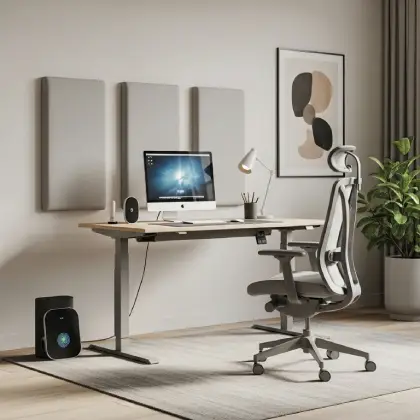
Working in an Office

When we talk about office work versus remote work, one thing stands out clearly: the daily commute. It's fascinating how the way we get to work can shape our health in ways we often overlook.
Take people who walk or bike to work, for example. The difference is striking. It's not just about getting your steps in. Active commuting can lower the risk of heart disease, improve fitness levels, and elevate your mood. Studies show that those who walk or bike to work often feel happier and perform better throughout the day. In many cases, the commute itself becomes a source of energy and clarity, helping set a positive tone before the work even begins.
But not everyone can walk or bike to work. Many people rely on cars, buses, or trains, which means they miss out on that active time. Research shows that long periods of sitting in traffic or on public transit can have negative effects on both physical and mental health. So when we talk about traditional office work, we need to consider how the commute shapes overall well-being.
Working from Home (remote work)
Working from Home
(remote work)
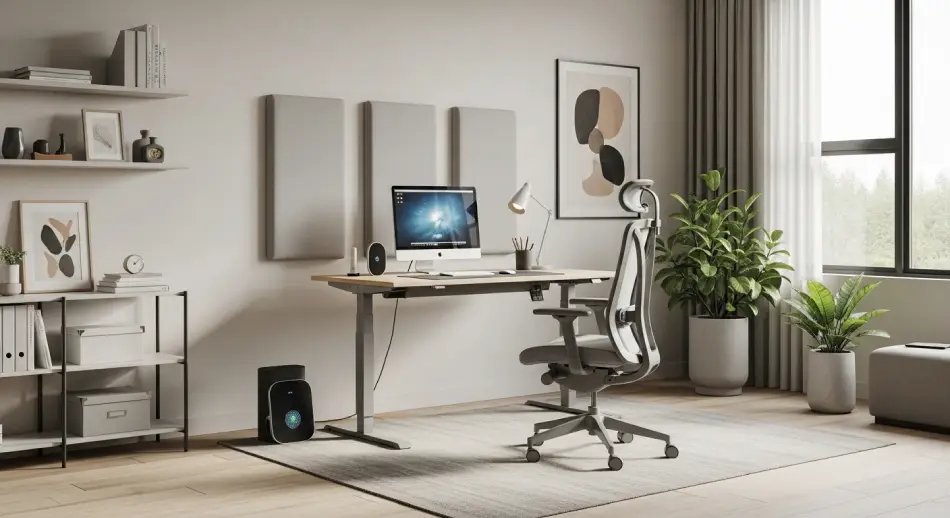
Let's flip the script and talk about working from home. One of the biggest shifts is the absence of a commute. Suddenly, you have more time in your day, and research shows that this extra time can make a meaningful difference in your overall well-being.
When you work from home, those extra hours can be spent on things that bring you joy and balance. You might use that time to fit in a workout, cook a nourishing meal, or simply catch up on sleep. The shift is subtle but powerful. Remote work gives you more control over your day, and that sense of autonomy can make a real difference in how you feel, think, and show up.
Some people might point out that commuting, especially by walking or biking, can be a great way to stay active and get fresh air. And they're absolutely right. But working from home offers something different: flexibility. You can move your body when it suits you, not just when your commute allows. It's about having the freedom to care for yourself in the way that feels most natural and sustainable.
How Remote Work Affects Your Health
How Remote Work
Affects Your Health
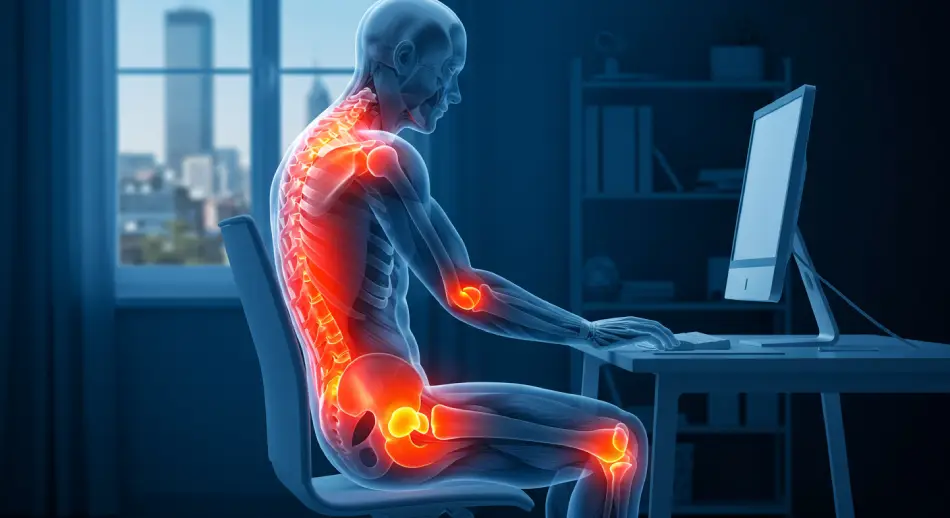
Working from home definitely has its perks, but it can also affect your health in ways you might not expect. The good news is that there are simple, effective ways to stay on top of it. Think of this as your personal guide to navigating the subtle health challenges that come with remote work and turning them into opportunities for balance and well-being.
🪑🧍♂️ The Sneaky Problem: Bad Posture
Let's start with something that creeps in quietly when you begin working remotely: bad posture. When your “office” is your couch, kitchen counter, or even your bed, it's easy to forget about setting up a space that actually supports your body. Without proper ergonomics, slouching becomes second nature. You might not notice it at first, but over time it can snowball into back pain, neck strain, and a general sense of discomfort that drags down your day.
So what can you do?
- Sit Right: It might sound simple, but being mindful of your posture can make a big difference. Aim for a straight line from your ears to your shoulders and down to your hips. Keep your back straight, your feet flat on the floor, and your shoulders relaxed. Even small adjustments can help reduce strain and keep your body feeling good throughout the day.
- Avoid Twisting: Take a moment to check how your workspace is set up. Are you turning your head to one side to see your monitor? Reaching awkwardly for your mouse or keyboard? Try to position everything you use regularly, like your laptop, monitor, keyboard and mouse, directly in front of you. This helps you avoid twisting your body throughout the day and reduces the risk of strain and discomfort.
- Use Good Furniture: It might feel like a big investment, but choosing a supportive chair and desk setup really pays off over time. Look for a chair with lumbar support and adjustable height, and make sure your desk allows your feet to rest flat on the floor. These small details make a big difference in how your body feels after a long day. Your back will thank you later.
🚶♀️🕒 Less Movement: The Sitting Trap
Next up, let's talk about another subtle shift that happens with remote work. It affects how much we move, or more accurately, how much we don't.
Back when you commuted to an office, movement was built into your day. Walking to catch the train, grabbing coffee, heading to meetings, chatting with coworkers. All of it added up, and you were probably getting more steps than you realized.
But at home, everything is within arm's reach. That might feel convenient, but it often leads to a steep drop in daily movement. Over time, this can contribute to weight gain, sluggishness and even metabolic issues.
Here's how to fight the sitting trap:
- Move Every Hour: One simple but powerful habit is to make it a goal to move every hour. Set a timer or use a reminder app to nudge yourself, and break up long sitting stretches with a few minutes of movement. Stand up, stretch, walk around your home, or do a quick set of squats or jumping jacks. Even short bursts of activity can boost circulation, improve focus and help you feel more energized throughout the day.
- Use a Sit-Stand Desk: If it fits your budget, a sit-stand desk can be a game changer. Switching between sitting and standing throughout your workday helps you stay energized and reduces stiffness. Some research even suggests it can improve focus and boost productivity. It's a simple upgrade that can make a big difference.
👀💻 Too Much Screen Time: Eye Strain and Fatigue
Screens can be demanding, and when you're working from home, it's easy to spend even more time staring at them than you did before. That extra exposure can lead to digital eye strain. You know the symptoms: tired eyes, dryness, headaches and that drained feeling that creeps in by the end of the day.
The good news is there are simple ways to fight back and give your eyes the break they deserve.
Here are a few tips to help:
- Adjust Your Screen: Start by tweaking your screen settings to reduce strain. Increasing the font size can make text easier to read without squinting. Adjust the contrast and brightness until it feels comfortable for your eyes. You might also want to use a blue light filter, especially in the evenings. Some studies suggest it could help reduce eye fatigue and improve sleep quality.
- Good Lighting: Make sure your workspace has soft, balanced lighting. Harsh overhead lights or bright lamps can create glare on your screen, which puts extra strain on your eyes. Try to position your monitor so it doesn't face a window directly. This helps reduce reflections and keeps your screen easy to look at throughout the day.
- 20-20-20 Rule: Here's a simple trick that can make a big difference. Every 20 minutes, take a short break and look at something at least 20 feet (6 meters) away for 20 seconds. This gives your eyes a chance to reset, helps reduce strain and can even improve your focus over time.
🍿🥤 Snacking Too Much: The Kitchen Temptation
When you're working from home, having constant access to snacks can be a bit of a double-edged sword. It's easy to fall into the habit of mindless munching, especially during long stretches at your desk. Over time, this can lead to weight gain and other health issues that sneak up on you.
So how do you combat this? It starts with a little intention and a few thoughtful routines.
Here's what you can do:
- Meal Planning: Routine makes a big difference. Back in the office, you probably had set meal times. Try to stick to a similar schedule at home. Plan your meals and snacks ahead of time, and when it's time to eat, step away from your workspace. Giving your full attention to your food helps you avoid mindless munching and makes mealtime feel more intentional.
- Stay Hydrated: Drinking enough water throughout the day is a simple but powerful habit. Staying hydrated helps you feel fuller and can reduce those sneaky hunger pangs that show up between meals. Keep a water bottle nearby and sip regularly. It's a small change that can make a big difference in how you feel and how often you reach for a snack.
🤝💬 Feeling Lonely: The Social Impact
Let's talk about something that often flies under the radar: loneliness. Working from home gives you flexibility, but it can also feel isolating. You might miss the spontaneous chats with colleagues, the office banter and the everyday buzz of being part of a team.
The good news is that there are ways to stay connected and bring more social energy into your routine.
Here are some ideas:
- Get Out Sometimes: Try working from a different location at least once a week. Whether it's a coffee shop, library or co-working space, a change of scenery can refresh your mind and help break the monotony. Being around other people, even if you're not interacting directly, can lift your spirits and make the day feel more dynamic.
- Stay Social: Make an effort to spend time with friends outside of work. Whether it's going for a walk, running errands together or catching a movie, these moments help you stay connected and grounded. Maintaining social ties is especially important when you're working remotely, since it helps balance out the solitude and keeps your relationships strong.
📱🧠 Distractions: The Focus Challenge
Let's wrap up with one of the trickiest parts of working from home: distractions. While the environment can be peaceful, it also comes with plenty of interruptions. There's laundry waiting to be done, family members asking for attention, and the constant pull of social media. These small disruptions can add up and seriously impact your focus and productivity.
The good news is that there are ways to manage them and stay on track.
Here's how to regain your focus:
- Create a Schedule: Just like in the office, having a structured workday makes a big difference. Set clear hours for when work starts and ends, and stick to them. This helps define boundaries between work and personal time, making it easier to stay focused and avoid distractions.
- Dedicated Workspace: Having a dedicated workspace can make a big difference in your ability to concentrate. It doesn't have to be a full office. Even a small, defined area can help shift your mindset into work mode. When you consistently use the same space for work, it becomes easier to get into a productive groove. It also sends a clear signal to others at home that you're focused, even if you're only a few steps away.
Back & Neck Pain from Desk Work
Back & Neck Pain
from Desk Work
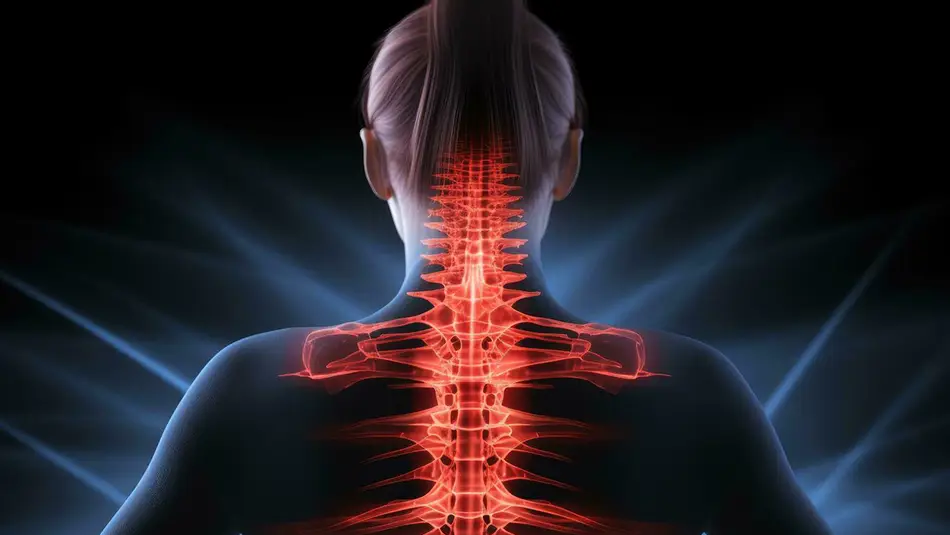
Healthy Workspace
The goal is to fine-tune your remote workspace so you can avoid those nagging aches that tend to show up after long hours of sitting. We'll focus on two key areas: designing a smart, supportive workspace and incorporating movement and exercise into your routine. This second part is often overlooked, but it plays a crucial role in keeping your body pain-free and energized.
Tips for Staying Pain-Free:
Tips for Staying
Pain-Free:
🕺🧘♂️ Stay Active
Get Up and Move:
Even with a well-designed desk setup, sitting for extended periods can lead to stiffness and fatigue. Make it a habit to stand up, stretch, or take a short walk every 30 to 60 minutes. These small breaks help your body stay loose and your mind refreshed, making it easier to stay productive throughout the day. [1]
💺✅ Choose the Right Chair
Support Your Back:
When choosing a chair, focus on functionality over appearance. Proper lumbar support is essential to maintain the natural curve of your lower back. Make sure your feet rest flat on the floor, your knees form a 90-degree angle, and you sit upright rather than leaning into your screen. A well-designed chair can make a big difference in your comfort and long-term health. [1]
↕️🖥️ Consider a Sit-Stand Desk Converter
Change Positions:
Sit-stand desk converters are a great way to reduce strain throughout the day. They let you switch between sitting and standing with ease, helping to relieve pressure on your back and neck. Changing your posture and weight distribution regularly can make a noticeable difference in how you feel. When choosing one, take into account your available space and budget. The benefits for your spinal health are well worth the investment. [1]
🛏️🚫 Avoid Working from Bed
Use a Proper Desk:
Let's talk about a tempting workspace option: your bed. While it might feel cozy, it offers little to no back support and can quickly lead to discomfort. It's important to set up a proper desk and use an adjustable chair to maintain good spinal alignment. Your bed should be a place for rest and recovery, not for work. [2]
💪🧠🩸 Exercise and Pain Management
Let's explore something that might not be the first thing you think of when it comes to pain relief: exercise. When your day involves long hours of sitting, regular physical activity becomes essential. It helps counteract the strain on your back and neck, supports your posture, and keeps your body functioning at its best.
Strengthen Your Muscles:
Build a natural support system. One of the key benefits of exercise is its ability to strengthen the muscles that support your spine, especially your back, core, and neck. Stronger muscles offer better stability and help reduce the load on your spine. Over time, this creates a natural brace that protects against strain and discomfort, making everyday movement feel easier and more balanced. [3]
Enhance Flexibility:
Stay loose and limber. Flexibility is just as important as strength when it comes to preventing pain. Stretching regularly helps keep your back, neck, and surrounding muscles loose, which eases stiffness and can relieve existing discomfort. By integrating gentle stretches throughout your day, you give your body the chance to reset and stay mobile. This small habit can lead to big benefits over time. [4]
Increase Blood Flow:
Fuel your recovery. Exercise does more than build strength. It also boosts your circulation. Better blood flow means your back and neck muscles receive more oxygen and nutrients, which helps repair micro-tears and reduce inflammation. This improved delivery system supports healing and keeps your muscles feeling refreshed and resilient. [4]
Alleviate Stress:
Support your mind and body. Stress and physical discomfort often go hand in hand. Exercise is a powerful way to break that cycle. It releases endorphins, which act as natural painkillers and mood boosters. By staying active, you're not just easing physical tension. You're also lifting your mood and supporting your overall mental well-being. [5]
Impact of Long Sitting on Hips and Legs
Impact of Long Sitting
on Hips and Legs
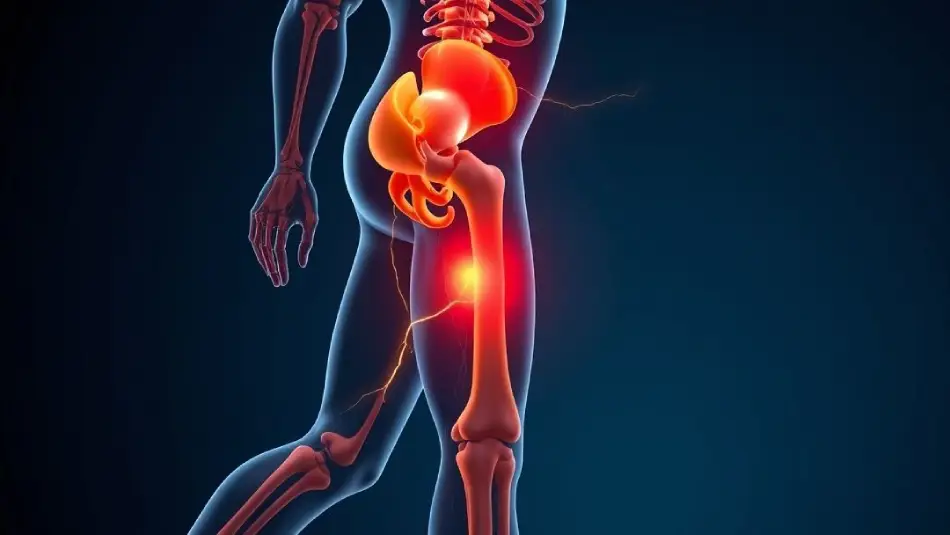
Sitting for long periods is like pressing pause on your body. When you remain seated too long, your hip flexors, the muscles that connect your thighs to your pelvis, become tight and stiff from staying in a shortened position. This tightness makes it harder to move your hips smoothly and can affect your overall flexibility and mobility.
Prolonged sitting has a major effect on your glute muscles, which are vital for leg strength, balance, and maintaining good posture. When these muscles weaken from inactivity, it creates an imbalance that places extra stress on your lower back. This added strain can lead to discomfort and may increase the risk of long-term spinal problems and chronic pain.
One of the more concerning effects of prolonged sitting is the reduction in blood flow to your legs. When circulation slows, you may notice symptoms like stiffness, swelling, and general discomfort. In more serious cases, poor blood flow can increase the risk of developing conditions such as deep vein thrombosis (DVT), where blood clots form in the deeper veins of the legs. Staying sedentary for too long can quietly undermine your vascular health, so regular movement is key.
Here are some key health risks associated with prolonged sitting:
🩸⚠️ Reduced Blood Flow:
Keep your circulation moving. Prolonged sitting slows blood circulation in your legs, which can lead to swelling, aching, and discomfort. When blood flow is reduced, your muscles and joints receive less oxygen and fewer nutrients. This lack of nourishment contributes to fatigue, stiffness, and a general sense of discomfort that builds over time. [6]
🦵🔄 Varicose Veins:
Watch for circulatory warning signs. When blood flow is compromised, it can begin to pool in your veins. This buildup leads to swelling and the formation of twisted, enlarged veins, commonly known as varicose veins. While they may seem like a cosmetic issue at first, varicose veins can cause pain and may signal deeper circulatory problems that need attention. [7]
🧘♂️🦴 Tight Hip Flexors:
Flexibility starts at the hips. Spending long hours sitting keeps your hip flexors in a shortened position, which leads to tightness and reduced flexibility. As these muscles stiffen, your range of motion decreases, making everyday movements like walking, bending, or climbing stairs more difficult. Over time, this can affect your posture and overall mobility. [8]
🦴⚠️ Hip Joint Stress:
Protect your joints from prolonged pressure. Staying seated for extended periods places unnecessary stress on your hip joints. Over time, this constant pressure can lead to discomfort and may contribute to joint issues such as osteoarthritis. Prioritizing movement throughout your day helps reduce this strain and supports long-term joint health. [9]
🦵📉 Weaker Leg Muscles:
Don't let sitting sap your strength. Prolonged inactivity weakens your glutes and leg muscles, eroding the foundation of strength and stability. As these muscles deteriorate, your physical performance suffers, and your risk of injury increases. Staying active helps preserve muscle tone and keeps you moving with confidence. [10]
🦵😣 Joint Pain:
Keep moving to keep pain at bay. Prolonged inactivity can starve your joint cartilage of essential nutrients. Without regular movement, the cartilage begins to wear down, leading to degeneration. Over time, this can result in joint pain and discomfort during everyday activities. Staying active helps nourish your joints and maintain mobility. [11]
🦵🔒 Limited Mobility:
Tight muscles, tighter limits. Your muscles respond to how often you use them. When they're inactive for long periods, they tighten and lose flexibility, making them more prone to cramps and strains. This stiffness can limit your ability to stretch properly or move safely during physical activity. Regular movement helps maintain mobility and keeps your body ready for action. [12]
Tips to Combat the Effects of Sitting
Tips to Combat
the Effects of Sitting
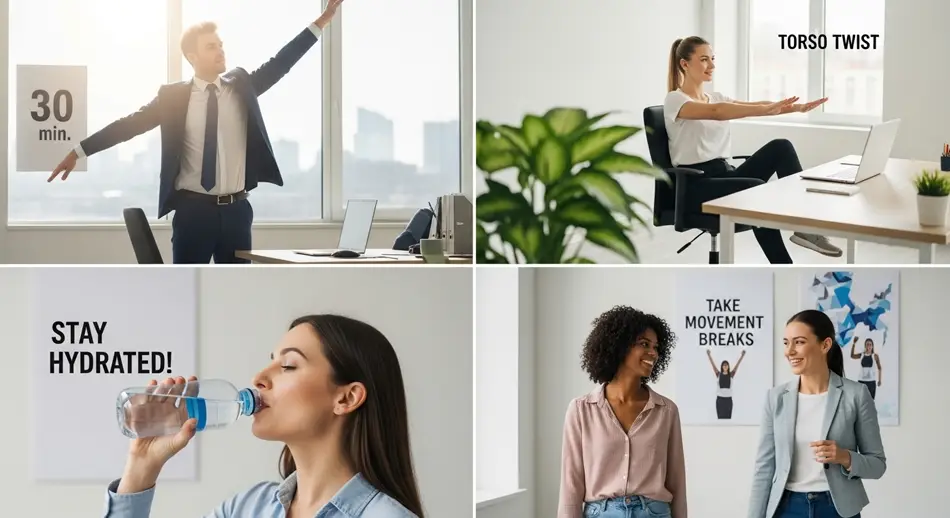
Let's dive into practical strategies that help counteract the negative impact of prolonged sitting. These simple habits can keep your body feeling strong, mobile, and energized throughout the day.
🚶♂️🔁 Get Moving Regularly:
Small movements, big impact. Make it a habit to stand up, stretch, or walk around every 30 to 60 minutes. These brief breaks help stimulate blood circulation, reducing swelling and discomfort in your legs and feet. Even a quick stroll around your home or office can make a noticeable difference. Regular movement not only refreshes your body but also sharpens your focus and boosts productivity.
🪑🏋️♂️ Incorporate Desk Exercises:
Stay active without leaving your chair. You don't have to leave your desk to keep your body engaged. Try these simple exercises right at your workstation to boost circulation and maintain strength:
- Seated Marches: Lift your knees one at a time as if marching in place while seated. This simple movement activates your hip flexors and boosts circulation, helping to counteract stiffness from long sitting sessions.
- Leg Lifts: While seated, extend one leg at a time and hold briefly before lowering it. This simple movement strengthens your quadriceps and enhances the flexibility of your hip joints, helping to counteract stiffness from prolonged sitting.
- Ankle Circles: While seated, lift your feet slightly off the ground and rotate your ankles in slow, controlled circles. This gentle movement helps maintain joint mobility and encourages healthy blood flow, especially during long periods of sitting.
💧🥤 Stay Hydrated:
Fuel your body with every sip. Hydration is essential for healthy circulation and overall bodily function, yet it's often overlooked. Drinking enough water throughout the day helps increase blood volume, supports nutrient delivery, and reduces fluid retention.
Keep a water bottle on your desk as a visual cue to sip regularly. Staying hydrated also encourages natural movement. Whether you're refilling your bottle or heading to the restroom, these small breaks help interrupt long sitting sessions and keep your body active.
🤸♂️📈 Engage in Regular Exercise:
Build strength beyond the desk. Make time for physical activity outside of your work hours. Aim for at least 150 minutes of moderate aerobic exercise each week. Walking, running, dancing, swimming, or cycling are all great options. Regular movement improves circulation, strengthens muscles, and boosts endurance, helping to counteract the physical toll of prolonged sitting.
Additional Recommendations
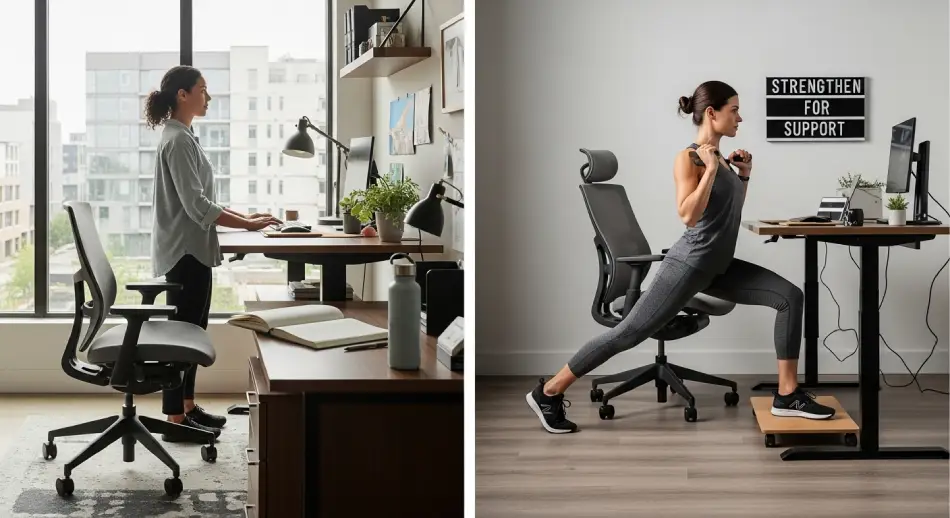
↕️🖥️ Consider a Sit-Stand Desk:
Shift positions to stay energized. If possible, invest in a sit-stand desk that lets you alternate between sitting and standing throughout your workday. This simple adjustment helps break up long periods of inactivity and reduces the strain of staying in one position. Make it a habit to stand during phone calls or virtual meetings to get the most out of your setup and keep your body engaged.
🏃♂️💪 Strengthen Supporting Muscles:
Build a solid foundation from within. Your glutes and core are essential for stabilizing your body and supporting your hips, especially during long periods of sitting. Incorporate exercises like lunges, squats, and planks into your routine to target these key muscle groups. Strengthening them improves posture, enhances stability, and provides better support for your spine and hips throughout the day.
Conclusion
By integrating these strategies into your daily routine, you can effectively reduce the negative impact of prolonged sitting. Not only will this support your overall health, but it will also help keep your back, neck, hips, and legs mobile and functioning at their best.
It's important to remember that small changes can lead to meaningful improvements in how you feel, both physically and mentally. Even minor adjustments throughout your day can make a noticeable difference in your overall well-being. Take it one step at a time, stay consistent, and you'll be well on your way to feeling stronger, more energized, and more comfortable in your body.
If something starts to hurt, don't brush it off. Take a moment to reflect on what might be causing the discomfort. Was it a specific movement, a prolonged posture, or the way you were sitting? Paying attention to your habits and positioning can help you identify potential triggers and make adjustments before the issue worsens.
If the pain persists or starts interfering with the activities you enjoy, it's wise to consult a doctor or physical therapist. They can help identify the root cause of your discomfort and offer personalized strategies to relieve it. Professional guidance ensures you get the right support to improve your well-being and manage pain effectively.